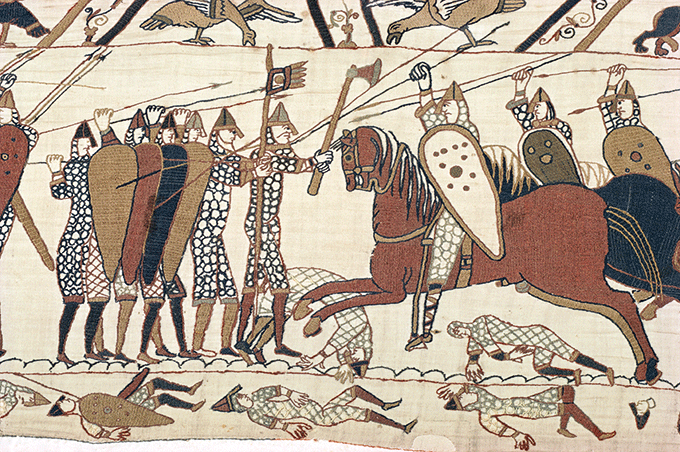Unit 1: Anglo-Saxon England, c1060–66
Use the copy of the textbook below to complete the tasks in the PowerPoints:
Anglo-Saxon Textbook

Lesson 1: A Researched Title Page
Lesson objectives:
-
To independently find out more about this course.
Use the PowerPoint to help you create your own independently researched title page.
You will need to divide your title page into 3 sections:
-
Anglo-Saxon England
-
1066
-
Norman occupation and Anglo-Saxon resistance
Use text and colourful illustrations. The top tips are there to help!
Researched Title Page
Topic Sheet

Lesson 2: Anglo-Saxon Society
Lesson objectives:
-
To contextualise Anglo-Saxon England within the history of Britain.
-
To be able to describe who the Anglo-Saxons were and where they came from.
-
To be able to explain some of the key features and the structure of Anglo-Saxon society.
A good explanation:
https://www.youtube.com/watch?v=7X6cZrFdQpQ
Anglo-Saxon Society
Anglo-Saxon Social System
Kingdom Maps

Lesson 3: Anglo-Saxon Administration and the Church
Lesson objectives:
-
To be able to distinguish and describe Anglo Saxon administration units.
-
To be able to identify the roles of different groups/individuals within Anglo Saxon society.
-
To think of examples of places which take their names from Anglo-Saxon words.
Extension: Use the map to fill in the examples of Anglo-Saxon place names
Anglo-Saxon Admin and the Church
Place names
Map

Lesson 4: The Anglo-Saxon Blood Feud
Lesson objectives:
-
To consolidate learning on Anglo-Saxon law and order & society
-
All to be able to confidently define:
Hue and Cry, Tithing, Blood feud, Wergild and Shire Reeve -
Most to be able to explain different classes in Anglo-Saxon society
A good explanation:
The Anglo-Saxon Blood Feud
Comic Strip Task
Keywords match up

Lesson 5: Religion
Lesson objectives:
-
To examine Anglo Saxon religious beliefs.
-
To analyse changes in Anglo-Saxon religious practices over time.
-
To assess the power of the Church, including the role of Church figures as advisors to the king.
Anglo-Saxon Religion
Video Questions
Living in the Middle Ages

Lesson 6: Monarchy and Government
Lesson objectives:
-
To consolidate learning so far on Anglo-Saxon society in preparation for a key assessment next lesson by preparing a display of key terms
-
To be able to explain who Edward the Confessor was and some key details about him.
-
To be able to describe the powers of the Anglo-Saxon monarchy during his reign
Monarchy and Government

Lesson 8: Edward the Confessor
Lesson objectives:
-
To be able to summarise and categorise information relating to the reign and characteristics of Edward the Confessor
-
To draw conclusions about Edward’s suitability for kingship.
-
To assess how events in Edward’s life may have had an effect on how effective he was as a king.
Edward the Confessor
Biography of Edward the Confessor

Lesson 10: Tostig Godwinson
Lesson objectives:
-
To be able to explain how Harold Godwinson ended up turning against his own brother.
-
To be able to identify key reasons there was an uprising againstTostig.
-
To evaluate what the consequences of these events were for Harold Godwinson and the King.
Tostig
Tostig rebellion story telling task

Lesson 13: Claimants to the throne
Lesson objectives:
-
All to be able to name the 4 claimants to the throne
-
Most to understand the details of the different claims to the English throne in 1066.
-
Some to effectively evaluate the different claims to the throne and decide who deserved it the most.
Claimants to the throne

Lesson 15: Battle of Gate Fulford and Stamford Bridge
Lesson objectives:
-
All will be able to explain what happened at the Battle of Gate Fulford and the Battle of Stamford Bridge
-
Most will be able to identify the battle tactics that made the victors successful at each battle.
Battle of Gate Fulford and Stamford Bridge
Lesson 17: Why William Won
Lesson objectives:
-
To be able to summarise events of the battle in chronological order.
-
To compile reasons for why William won the Battle of Hastings.
-
To be able to prioritise factors leading to William’s victory at Hastings.
-
To explore the significance of the Bayeux Tapestry
Why William Won
Reasons William Won
Bayeux Tapestry Sequence


Lesson 18: Interpretations of 1066
Lesson objectives:
-
To use humour to demonstrate understanding of events in 1066
-
To analyse causes and consequences of events in 1066
-
To enhance essay skills by considering different interpretations of an event and developing an appropriate line of argument
Interpretations of 1066
Memes






